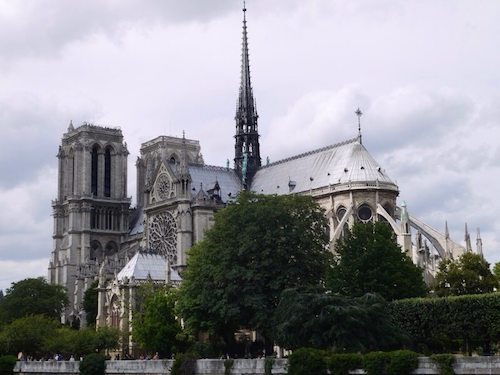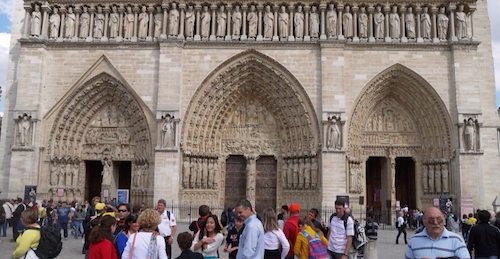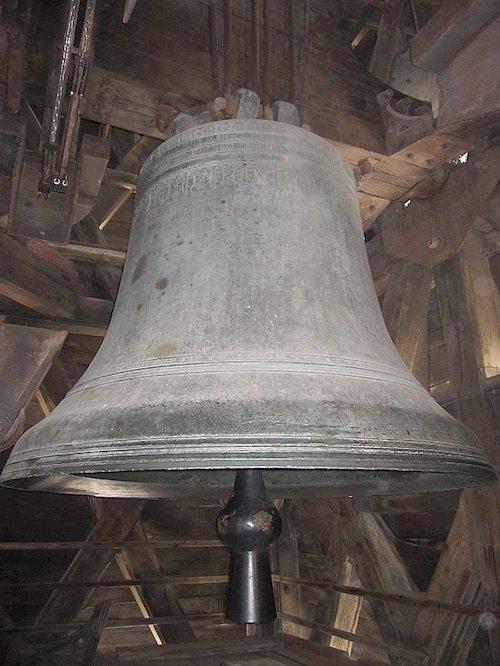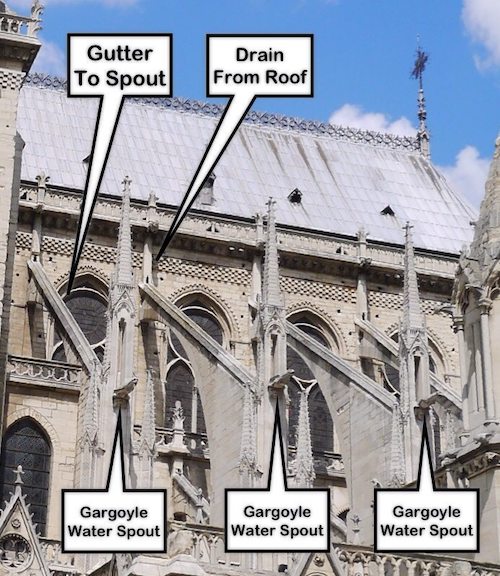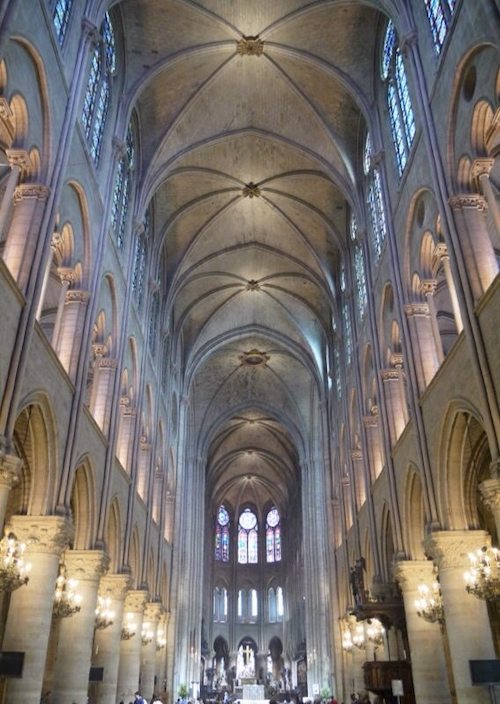I thought we would visit Notre Dame today, since it was good weather and we felt like an adventure. The cathedral is located on the east end of the Île de la Cité, one of two remaining islands in the Seine and home to the first inhabitants of Paris, the Celtic tribe Parisii.
I personally think the east side of Notre Dame shown above is more picturesque than the western facade shown to the right, primarily because you can see the “flying buttresses” that were added when cracks began showing in the fairly thin gothic walls. However, the western facade is packed with statues and carvings, most of which have religious meanings. Built in an age of illiteracy, the cathedral retells the stories of the Bible in its portals, paintings, and stained glass.
In 1160, because the church in Paris had become the “Parisian church of the kings of Europe”, Bishop Maurice de Sully deemed the previous Paris cathedral, Saint-Étienne (St Stephen's), which had been founded in the 4th century, unworthy of its lofty role, and had it demolished shortly after he assumed the title of Bishop of Paris. Construction began in 1163, during the reign of Louis VII, and opinion differs as to whether Sully or Pope Alexander III laid the foundation stone of the cathedral. Bishop Sully died in 1196, the western facade was finished in 1225 and the remaining elements were completed by 1345.
In 1768, geographers decided that all distances in France would be measured from Notre-Dame. One hundred and seventy-six years later, when Paris was liberated during World War II, General de Gaulle rushed to the cathedral after his return, to pray in thanksgiving. In many ways, Notre-Dame was and still is the center of France. The picture to the left is the marker in the Notre Dame Plaza.
To start with, the cathedral has three entrances or portals, the center one devoted to “The Last Judgement” is usually closed, the right “Portal of St Anne” is usually where visitors enter and the left “Portal of the Virgin” is where visitors usually leave.
The King's Gallery is a line of statues of the 28 Kings of Judah and Israel, at the top of the above picture, which was redesigned by Viollet-le-Duc to replace the statues destroyed during the French Revolution. The revolutionaries mistakenly believed the statues to be French kings instead of biblical kings, so they decapitated them.
The buttresses feature niches that house four statues restored by Viollet-le-Duc’s workshop. The left above (North) buttress depicts the deacon Saint Stephen, the right above (South) buttress shows Saint Denis, and the buttresses on the sides of the central portal portray two allegories, the Synagogue on the right (center right above) and the Church on the left (center left above). The one that cracks me up is the synagogue one showing the snake of Judea blocking the view of the young woman, a pretty strong artistic statement for a religion that has it's roots in Judaism. In her depiction, the synagogue statue has lost her crown and the laws of Moses seem to slipping out of her hand, while the church statue has her crown and is proudly holding the symbols of the church.
There are literally thousands of sculptures on each portal which even an obsessive compulsive person like me finds daunting. For a really detailed and informative description of the center “Last Judgement” portal go to Sacred Destinations. The center portal was the last one finished in 1230 and has been recently cleaned and fully restored
As you are leaving Notre Dame, you come upon this interesting statue holding his head, Saint Denis. Saint Denis is a patron saint of France and, according to legend, was the first bishop of Paris.
Legend says that he was decapitated on the Hill of Montmartre. To account for his tomb being at Saint Denis, several miles away, legend states that Denis carried his head to the site of the current church, thereby indicating where he wanted to be buried. If you look around Paris, you will see lots of statues and paintings devoted to him including the Basilica of Saint Dennis, the first Gothic cathedral in France and the Pantheon, where the photo shown to the right was taken.
This façade’s simplicity and harmony has fascinated modern art historians and contemporary architects. Marcel Aubert wrote that it was “one of the Middle Ages’ most famous, a masterpiece of composition and execution,” and Le Corbusier called it a “pure creation of the spirit”. He thought that the determining surface is governed by the circle and the square, which explains its geometric purity. The square stands for created, limited space, the image of man's world, the circle stands for the boundless, the perfect figure without beginning or end, the image of God. The heads of the Virgin and Jesus fall directly into the centre of the West rose window. Mary’s acceptance allowed God, as Jesus, to come into the mortal world, and Mary presents her Son to the city. Measuring 10 meters (32.8 feet) in diameter, it was the largest rose window ever attempted when it was conceived. If you look carefully at the windows next to the rose on the second tier, you will see Adam in the middle of the left window and Eve on the right.
Since 1856, the four major bells atop the northern towers (to the left facing the facade) of the Cathedral of Notre-Dame have rung every 15 minutes, without fail. In 2012 the four bells will be replaced at a cost of 3.5 million dollars according to a report by The New York Times.
Before the French revolution, Notre-Dame had 20 renowned bells that pealed atop the northern and southern towers of the building. But after the revolution in 1789, all the bells save one were melted down to make cannons, (About 80% of the bells across France disappeared after the French Revolution.)
Not all the bells will be replaced. The great 1681 “Bourdon Emmanuel” bell (seen above), which hangs in the south tower (to the right facing the facade) and is considered one of the most beautiful in Europe, will be preserved. It rings for major religious celebrations, popes’ visits, presidential funerals and commemorations. Revolutionaries confiscated the Emmanuel bell but never destroyed it. It was put back in the southern towers at Napoleon’s request in 1802. It weighs 13 tons. On the night of August 24,1944, as the Île de la Cité was taken by an advance column of French and Allied armoured troops and elements of the Resistance, it was the tolling of the Emmanuel that announced to the city that its liberation was under way.
Many small statues are placed around the outside. These were crafted individually and served as supports for columns and water spouts as you can see to the left. Among these are the famous gargoyles. These were originally colored, as was most of the exterior. The paint has worn off, but the grey stone was once covered with vivid colors. The cathedral was essentially complete by 1345.

“The first spire was built at the transept crossing around 1250. It was taken down from 1786 to 1792. It was a bell tower, which in the 17th century housed up to 5 bells.
During Viollet-le-Duc's restoration of the cathedral, he decided to build a second spire, whose structure would be independent from the main cathedral, on an octagonal base supported by the four transept pillars.
The spire dominates the verdigris copper statues of the twelve apostles with the symbols of the four evangelists. Viollet-le-Duc represented himself as Saint Thomas holding a square. He seems to be contemplating the top of his “Great Work”. The spire dominates the verdigris copper statues of the twelve apostles with the symbols of the four evangelists. Viollet-le-Duc represented himself as Saint Thomas holding a square (middle statue on the right). He seems to be contemplating the top of his “Great Work”.
A few impressive figures about the spire; it took 500 tons of wood, 250 tons of lead and is 93m in height”. This entire section on the spire comes from “Cathedral Notre Dame de Paris” as does the image to the left, which is copyrighted by Cathedral Notre Dame de Paris. Two things about the image, I am too old to walk up the 400 odd stairs to take this picture and for the life of me I cannot figure out how to delete it. Apologies, Notre Dame.
It is now time to enter the cathedral. Upon entering, you are aware of the spooky beauty of the church. The ceiling is high, really high, like the sky and the light is different, coming from unfamiliar places. The picture taken above is untouched, taken just as I saw it.
Around the sides of the church are little niches with statues or devoted to specific saints. The baptismal font is shown to the right. The earliest baptismal fonts were designed for full immersion, and were often cross-shaped with steps (usually three, for the Trinity) leading down into them. As infant baptism became more common, fonts became smaller.
A gisant is the French word for a sculpture on top of the tomb in eternal repose often clothed in the formal attire of his social class or office as seen above. A further variant that developed during the Renaissance depicts the deceased in a semi-reclining pose, leaning on an elbow, awaiting the resurrection as if meditating, reading, or conversing, as seen to the right.
Along a wall separating the central nave from the side isles are a series of beautiful bas-reliefs illustrating the life and rebirth of Jesus. The picture above shows Jesus after his resurrection appearing to the holy women. Remember, these images were meant to relate the life of Jesus to a largely illiterate congregation.
I am going to close with this close up picture, see above, of the “Crown of Light” or great chandelier of the transept crossing. It has been brought down for renovation. I plan to do a separate post on the stained glass at Notre Dame.


